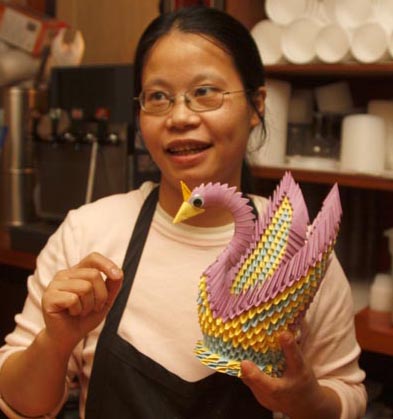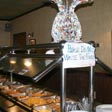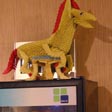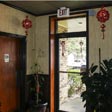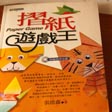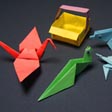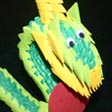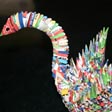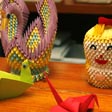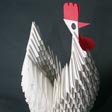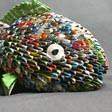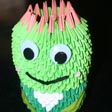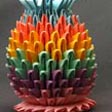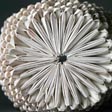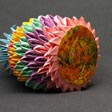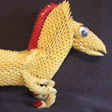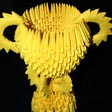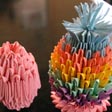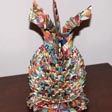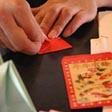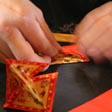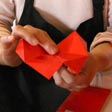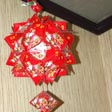Introduction to Delta Pieces: Northeast Louisiana Folklife
Map: Cultural Micro-Regions of the Delta, Northeast Louisiana

The Louisiana Delta: Land of Rivers








Ethnic Groups










Working in the Delta








Homemaking in the Delta



Worshiping in the Delta



Making Music in the Delta




Playing in the Delta







Telling Stories in the Delta



Delta Archival Materials
Bibliography

Qin Lin: Chinese Paper Crafts
Ferriday, LA
Qin Lin practices the Chinese art of crafting objects from paper.
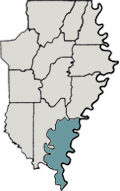
Qin Lin: Chinese Paper Crafts
By Susan Roach
The interior of the China Wok restaurant near downtown Ferriday, Louisiana, on Highway 15 looks similar to other Chinese restaurants found in Southern towns at first glance, but colorful hand-crafted paper animals and pineapples add a special touch, along with the red New Year's paper spheres hanging from the ceiling. The maker of these crafts, Qin Lin, a native of Fuzhou, China, happily talks about her craft when she can take a break from waiting on customers, serving as cashier, and taking take-out orders in the restaurant, which specializes in Szechuan and Cantonese food.
Qin Lin's journey to Ferriday and paper crafting was a long one. In 1995 when she was 19, she moved with her family from China to Manhattan, New York. Her father had come to the U.S. first and then sent for his family after he was settled and had the appropriate papers. Having attended school through the ninth grade in China, Qin Lin was able to continue high school in New York, where she studied English and computers. Her languages include both Mandarin and Cantonese, which she continues to speak today with her family, but she now knows enough basic English to speak it with her customers in the restaurant.
After finishing school, she obtained a job working in a clothing factory where she operated a sewing machine. Her task was to sew two pieces of fabric together, making the same seam in a particular garment all day. Given the repetitive job, it is no wonder that she craved more creativity in her life. In 2004, she married her husband who worked in a restaurant in New York. They soon moved on to Ferriday to open a restaurant, after they heard that there were no other Chinese restaurants there. Unfortunately, there is not a large, close-knit Chinese community there, so she calls her family as often as she can. In earlier days, Ferriday had boasted a larger Chinese community who had come to help build the railroads, but most of these families had moved on, leaving few Chinese traditions there.
While the paper crafts that fascinate Qin Lin were not necessarily traditional in her family in China, she says she has "always been interested in it." She recalls some paper crafts she saw as a child, but she did not make any herself then. She was inspired to begin doing the craft when the wife of an area Taiwanese doctor brought an example to show her, as she explains in our visit: "[His] wife had to go to the church and then go to the jail, the Waterproof jail, and go . . . help the poor, and then the lady in the jail, Chinese, I think, made a pineapple for her and a swan like that for her. And then [she, the doctor's wife] bring me this. I see that, and she take it home." After seeing the pineapple and swan, she became interested in the craft again, and a friend in New York City helped her find a Chinese book on the paper folding craft and bought her one. She learned how to make the different objects by looking at the ones in the book and recalling the ones that she saw in China. She relates that she can copy almost any design: "I can just look at it, and I can do. The pineapple—I look at it, and I make it. . . Some people—you can look and you don't know how to do. I just look at it. . . the easy one, I can do."
Qin Lin makes two different types of paper crafts: a simpler craft of one piece of paper that is folded into an animal or object shape, along the lines of Japanese origami, and the more complex craft that includes many small folded pieces that interlock to form a complex figure. She focuses mainly on the latter. In spite of her insistence, the more complex craft is quite intricate, but is made entirely from folded paper glued to a base.
As materials, Lin uses either glossy magazine pages or colored copy paper. Lin says it is important to think about the length of the paper and the color. She likes to use glossy, colorful magazines because the paper is thicker and the designs are more colorful. In some cases, she purchases colored copy paper when she wants to make a solid color object or have control over different bands of color. She says, however, that in China, these crafts are made from penny papers [old paper currency] instead of magazines. On some of her animals, she likes to use commercial black and white plastic button eyes which she glues on the head; on others she glues on a circle with black ink to draw the eyes.
Whether it is the simple one-piece object or the complex multi-piece object, the process requires careful cutting and folding. A specific craft begins with the cutting and folding of one small piece of paper. The more complex designs require a repetitive process of accurate cutting of the paper pieces, folding them, and then interlocking the separate pieces to shape the targeted object. She does not glue the pieces together, but glues on a base when the figure is complete, if the object requires it. Some such as her chicken do not require a base.
Qin Lin has an extensive repertoire of designs. While she does get many of her designs from her craft books, she says that she does put some of her own ideas into each piece. She can look at a figure and make it, adjusting the size of an object as she wishes. She judges an object to be a good one if it stands straight and has good color. While many of her designs made from magazine pages have an overall bluish cast, she does not seem to have favorite colors; she emphasizes that she "likes them all." Her repertoire includes both animals and objects: swan, duck, bird, chicken, dolphin, frog, horse, snake, dragon, teacup, vase, egg, and pineapple, to name her most common ones. According to Chinese folk belief, the pineapple brings good luck, so that is one of her favorite designs; it is also easier to make than the animals, with the pineapple taking her about a couple of hours. Her pineapple design is based in tradition and not on her books.
She also makes special decorations for Chinese New Year, but she hangs them during the Christmas-New Year holiday season, and they may stay up all year. These are made from special Chinese New Year red or orange money gift envelopes; she purchases these in New York City. These papers usually have decorative figures and may have the appropriate symbol and image of for the year, such as a fish, rabbit, or dragon. She uses this paper to fashion the ornamental faceted spheres that she puts together by creasing and folding each sheet into eight triangles. The outer triangles are fastened to the adjoining pieces, and the creasing strengthens the center of each envelope. Without the creases, the sphere would not retain its geometric integrity. The large spheres are suspended on a red cord; a smaller sphere with a paper tassel may hang a few inches below the larger sphere. Lin uses the spheres for decoration in the restaurant, and changes them out every New Year. Pieces are fastened inside and outside with clear tape. The folding is the same for each design. She says that some of the New Year's balls in New York were made with dollar bills, so they were green, but she has not done this. Lin uses her crafts not only for decoration, but also for gifts and for sale. Her son has taken to pineapples as gifts for his teacher. She has sent animal figures to a friend in Florida. She also hangs some at Christmas. She has also passed along the craft to one of her friends. An affinity for the craft seems to run in the family as her sister in China also makes pineapples. While she does not have prices on her crafts that indicate that they are for sale, when people inquire, she does tell them that they can be purchased. Her prices average from $10-30. She likes to make them when she has spare time in the restaurant and at home where she cares for their two young sons.
She loves to make all of her crafts and enjoys doing different ones. When asked why, she responds, "I like to do it. I want to learn more, maybe. I like to do this." As for why it appeals to her, it would seem that it has some connection to her Chinese roots. Ironically, unlike the repetitive action required in her first factory job in which she put together one small part of the whole, her paper crafts with their repetitive folding result in a whole creative process that she controls from start to finish. The repetition required in the craft provides her with a meditative, haptic creative outlet that produces delightful creations that she can enjoy, display, share, and sell right there in her restaurant.



